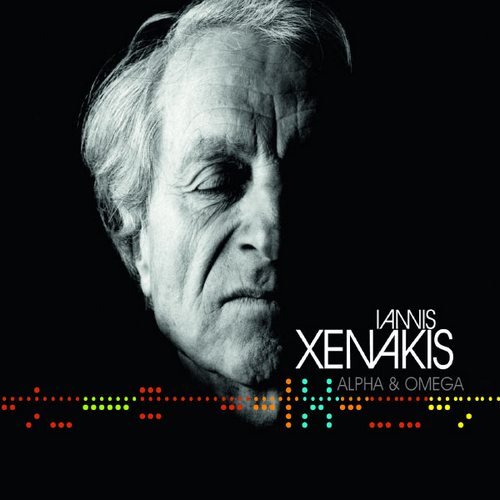Iannis Xenakis - Alpha & Omega (4CD BoxSet) (2011)

Artist: Iannis Xenakis
Title: Alpha & Omega
Year Of Release: 2011
Label: Accord
Genre: Classical
Quality: FLAC (tracks+.cue,log,scans)
Total Time: 04:29:34
Total Size: 1,58 Gb
WebSite: Album Preview
Tracklist: Title: Alpha & Omega
Year Of Release: 2011
Label: Accord
Genre: Classical
Quality: FLAC (tracks+.cue,log,scans)
Total Time: 04:29:34
Total Size: 1,58 Gb
WebSite: Album Preview
CD 1:
1. Metastasis
2. Diamorphoses
3. Concret ph
4. Analogique a et b
5. Orient - occident
6. Morsima - aamorsima
7. Nomos alpha
8. Anaktoria
Hans Rosbaud (dirigent)
SWR Sinfonieorchester Baden-Baden und Freiburg [1]
Pierre Schaeffer (dirigent)
Groupe de Recherches Musicales de L'ortf [2-5]
Jacqueline Métano (piano)
Octuor de Paris [6]
Siegfried Palm (cello) [7]
Octuor de Paris [8]
CD 2:
1. Nuits
2. Persephassa
3. Synaphaï
4. Aroura
Marcel Couraud (dirigent)
Choeurs de l'O.R.T.F. [1]
Percussions de Strasbourg [2]
Geoffrey Douglas Madge (piano)[3]
Elgar Howarth (dirigent)
New Philharmonia Orchestra [3-4]
CD 3:
1. Antikhthon
2. Persepolis
Elgar Howarth (dirigent)
New Philharmonia Orchestra [1]
Iannis Xenakis (electronica) [2]
CD 4:
1. Charisma
2. Mikka
3. Mists
4. Keren
5. Keqrops
6. Oophaa
7. O-mega
Alain Damiens (klarinet)
Pierre Strauch (cello) [1]
Maryvonne Le Dizès (violin)[2]
Claude Helffer (piano)[3]
Benny Sluchin (trombone)[4]
Roger Woodward (piano)
Claudio Abbado (dirigent)
Gustav Mahler Jugendorchester [5]
Elisabeth Chojnacka (clavecin)
Sylvio Gualda (percussions)[6]
Roland Auzet (percussions)
Dominique My (direction)
Ensemble Fa [7]
Iannis Xenakis was a composer of Greek heritage and Romanian birth, known for his revolutionary ideas regarding the systematic, mathematical organization of music and its structural parallels with architecture, and for his pioneering work in electronic music. Xenakis' initial exposure to music came in the first ten years of his life, when he was surrounded by the folk music of the Romanian countryside and the liturgy of the Byzantine Orthodox Church. In 1942, when his family moved to Greece, he was exposed to the music of Beethoven and Brahms for the first time.
His life grew turbulent when he entered Athens Polytechnic with the intent of becoming an engineer. When Greece was invaded during the World War II, Xenakis became passionately involved with resistance and liberation groups, first protesting against Nazi rule and, later, opposing the British, who, in 1944, drove out the Germans but sided with right-wing politicians against the Greek National Liberation Front. Xenakis was seriously wounded, his face disfigured, when he was hit by a British shell; he also lost vision in one eye. As a member of the resistance, he was eventually arrested and sentenced to death. He escaped in 1947, hoping to reach the United States. He ended up settling in Paris, however, and taking French nationality. In Paris, Xenakis made numerous important contacts, befriending Messiaen, Honegger, Mihaud, and the celebrated architect Le Corbusier, who were all impressed by his innovative and brilliantly intellectual approach to music. Working with Le Corbusier, Xenakis was highly involved with civil planning and architecture, designing some landmark sites throughout the world. For him, architecture was musical, and music was architectural. He frequently used one to inspire the other, basing pieces on computer programs and complex mathematical equations. This approach resulted in highly theoretical, systematic music characterized by intricately calculated rhythms, dense and often explosive textural fields, extended timbral effects, and "clouds" of sound that contain countless "particles." Some of his most important works include the orchestral Metastasis (1954), Pithoprakta (1956), Nomos Alpha for solo cello, and groundbreaking electronic works such as Bohor I, and Concret P-H. Xenakis was the founder of the EMAMu in Paris and its American counterpart, the Center for Musical Mathematics and Automation in Bloomington, Indiana.
His life grew turbulent when he entered Athens Polytechnic with the intent of becoming an engineer. When Greece was invaded during the World War II, Xenakis became passionately involved with resistance and liberation groups, first protesting against Nazi rule and, later, opposing the British, who, in 1944, drove out the Germans but sided with right-wing politicians against the Greek National Liberation Front. Xenakis was seriously wounded, his face disfigured, when he was hit by a British shell; he also lost vision in one eye. As a member of the resistance, he was eventually arrested and sentenced to death. He escaped in 1947, hoping to reach the United States. He ended up settling in Paris, however, and taking French nationality. In Paris, Xenakis made numerous important contacts, befriending Messiaen, Honegger, Mihaud, and the celebrated architect Le Corbusier, who were all impressed by his innovative and brilliantly intellectual approach to music. Working with Le Corbusier, Xenakis was highly involved with civil planning and architecture, designing some landmark sites throughout the world. For him, architecture was musical, and music was architectural. He frequently used one to inspire the other, basing pieces on computer programs and complex mathematical equations. This approach resulted in highly theoretical, systematic music characterized by intricately calculated rhythms, dense and often explosive textural fields, extended timbral effects, and "clouds" of sound that contain countless "particles." Some of his most important works include the orchestral Metastasis (1954), Pithoprakta (1956), Nomos Alpha for solo cello, and groundbreaking electronic works such as Bohor I, and Concret P-H. Xenakis was the founder of the EMAMu in Paris and its American counterpart, the Center for Musical Mathematics and Automation in Bloomington, Indiana.

![Steinar Raknes Quartet - Live in Tokyo (2013) [Hi-Res] Steinar Raknes Quartet - Live in Tokyo (2013) [Hi-Res]](https://www.dibpic.com/uploads/posts/2025-12/1766420385_steinar-raknes-quartet-live-in-tokyo-2013.jpg)




![Rainer Brüninghaus, Kenny Wheeler, Jon Christensen & Brynjar Hoff - Freigeweht (1981/2025) [Hi-Res] Rainer Brüninghaus, Kenny Wheeler, Jon Christensen & Brynjar Hoff - Freigeweht (1981/2025) [Hi-Res]](https://www.dibpic.com/uploads/posts/2025-12/1766402111_cover.jpg)

